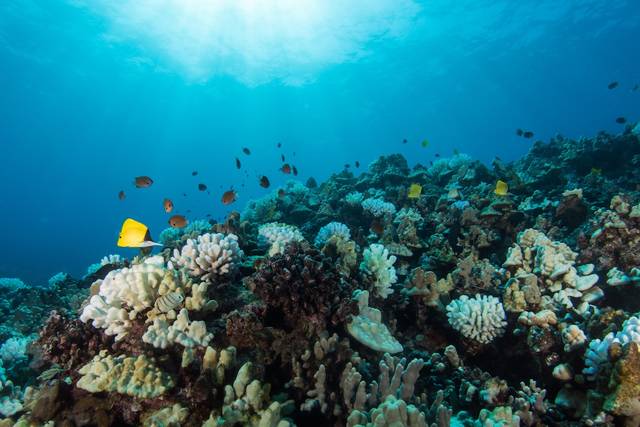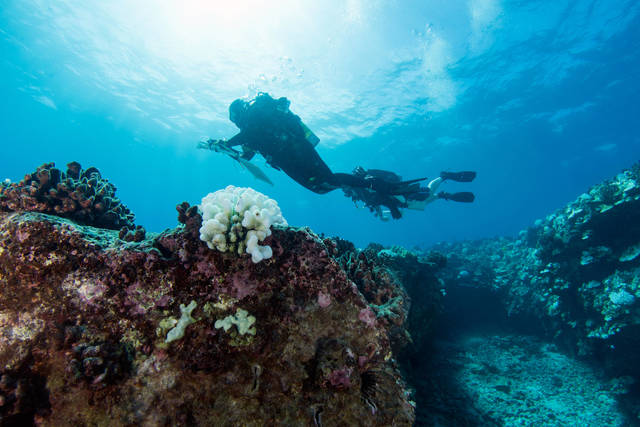Remote reefs with little exposure to human impacts were the most resilient during the 2015 bleaching event, according to a newly released analysis from The Nature Conservancy, which shows an overall recovery of Hawaii coral reefs since the incident.
TNC studied the coral reefs off the Kona coast of the Big Island, where an average of 60 percent of the corals bleached, with some reefs experiencing up to 90 percent mortality due to the 2015 bleaching. Corals bleach under stress, and severe or prolonged stress can lead to death, according to TNC.
On Kauai, corals battled black band disease from 2004 to about 2015 and did experience some impacts of bleaching, but in the last year, divers reported an increase in coral growth at Anini Beach on Kauai’s northeast side in March — a March report from underwater photographer Terry Lilley mentioned healthy and disease-free corals that “continue to grow at a rapid rate.”
Robin Mazor with Reef Guardians Hawaii, recently confirmed a steady increase in coral growth at Anini since then, and “expansion of the areas of growth.”
“Over the last few years we have also seen a lot of algae growth in the summers, and sediment covering coral after storms, and some areas that were previously thriving have lost their robust coverage,” Mazor said. “And yet next to these weakened zones are new and diverse coral forming beautiful gardens, housing fish nurseries, and bringing life back to the abandoned reef structures.”
She reported seeing very little bleaching compared to past bleaching events.
“Sediment is still stirring in the water, but the reef life is noticeably more plentiful,” she said.
For their most recent West Hawaii survey, TNC scientists surveyed more than 14,000 coral colonies at 20 sites along the West Hawaii coast from Kawaihae to Keauhou, and Eric Conklin, director of marine science for TNC’s Hawaii program, said they saw recovery, too.
“Bleaching events like what occurred in 2015 can overstress a coral reef to the point where it may never recover,” Conklin said. “We were thrilled to see that many of the area’s reefs have stabilized, which is the first step toward recovery.”
Grady Timmons, TNC communication specialist, said the organization hasn’t done any research on Kauai’s reefs, but “would like to in the future.”
Scientists and researchers from the state Department of Land and Natural Resources say they don’t yet have data to show recovery on Kauai from the bleaching event or to potentially quantify impacts of flood events in 2018 to coral.
“We do now have a monitoring team on island who will continue to annually monitor these sites and collect data,” DLNR’s Katie Nalesare said.
Part and parcel to the bleaching event in 2015 was black band disease, which creates wounds on coral and destroys live tissue, threatening the coral’s life. That was discovered on Kauai in 2004 and dissipated mid-2015, according to scientists.
Reports of the disease returning to Kauai’s North Shore surfaced in 2017, and scientists that studied the disease in 2015 with the U.S. Geological Survey, ReefGuardians Hawaii, National Oceanic and Atmospheric Administration, University of Hawaii and other non-governmental entities say there are many factors.
Some of those include weather, ocean conditions and human actions — like pollution of groundwater going into the ocean.
The reef at Anini Bay was identified as a reef “oasis” by the late Ruth Gates, former director of Hawaii Institute of Marine Biology, in a paper published in June 2018.
The paper identified a worldwide list of reefs that were doing better than most. On Kauai, data was taken from Limahuli, Milolii, Nualolo Kai and Hanalei on the North Shore, and at Hoai Bay across from Prince Kuhio Park in Koloa.
The recently released TNC surveys showed that many of the most resilient reefs are in remote areas with limited shoreline access and exposure to human impacts. These reefs had lots of corals and little or no coral disease, and there was evidence that new corals were beginning to grow, according to TNC.
Another factor was the number of stressors impacting a reef.
“Interestingly, the number of stressors affecting an area, not the severity of a single one, was the most important factor,” said Kim Hum, TNC’s marine program director. “Reefs that are fighting the impacts of several stressors are more susceptible to temperature stress, making them more likely to bleach and less able to recover if they do.”
Of the 25 coral species identified in West Hawaii by TNC, the lobe coral (Porites lobata) was the most resilient. It’s also one of the area’s most dominant species. Cauliflower corals (Pocillopora meandrina) were hardest hit — with 98 percent bleaching — but recent surveys show that they are beginning to recover.
“With more frequent and severe bleaching anticipated in the years ahead, there is a lot we need to do in West Hawaii and across the state to minimize the impacts of a warming climate on our reefs,” Hum said. “We can make sure remote areas with few stressors stay that way, and we can reduce pressures from over-fishing, land-based pollutants and runoff in more populated areas.
•••
Jessica Else, environment reporter, can be reached at 245-0452 or jelse@thegardenisland.com.




